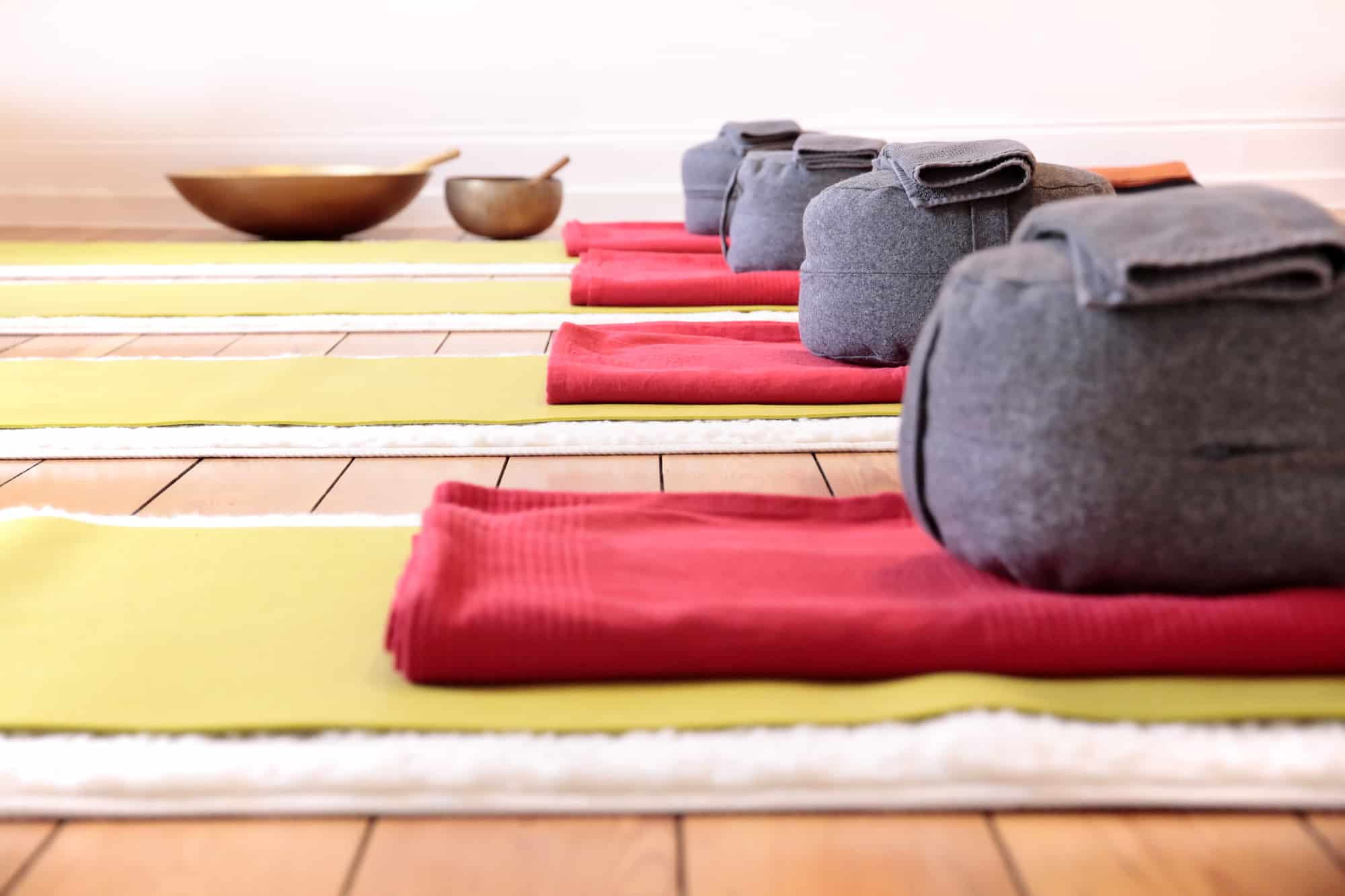Today yoga mat manufacturers use a wide variety of materials to produce yoga mats. They divide into two big groups: natural and synthetic. Some yoga mats are made of the mix of natural and synthetic materials. This whole thing can be confusing.
So, what material are yoga mats made of?
To answer this question shortly, let’s say that yoga mats can be produced from Polyvinyl Chloride (PVC), Thermoplastic Elastomer (TPE), and Polymer Environmental Resin (PER). On the other hand, there are also natural materials such as cotton, jute, natural rubber, and cork.
This short guide will answer the questions
- What material is used for yoga mats?
- Which yoga mat material is the best?
- What is the safest material for a yoga mat?
Before we start, let’s look into some yoga mat materials properties.
Yoga Mat Material Properties

Yoga mat materials have various properties that lead to them being more or less suitable for practicing yoga poses. Here are checkpoints you should consider before choosing a yoga mat.
Thickness
The more material is used to make the mat, the thicker it will be. Thicker mats allow more cushioning and comfort. But they are usually less portable.
Breathability
The density of the material defines its breathability. The denser the material, the less breathability it will have. The yoga mat with good breathability absorbs the body heat well and dissipates it fast. Here you’ll need to find the harmony between density and breathability.
5 Reasons Why You Need a Yoga Mat
Free of dangerous chemicals
Some cheap forms of PVC and EVA material bear risk to your health. Harmful chemicals are used in the synthesis of these substances. They may irritate the skin or release an odor that can cause allergies. So you’ll want your mat to be safe and made of non-harmful material.
Flexibility and weight
Flexible mats are easier to carry around and fold when it’s necessary. Some lightweight materials like cotton or TPE can make your yoga mat flexible enough.
Durability
The performance of your yoga mat is determined but its durability. And, of course, more durable mats last longer, which prevents your budget from any extra spending. Heat, water and abrasion resistance, tactile strength, and elasticity all define the durability of your mat. In addition, many synthetic materials like PVC, NBR, Polyurethane, TPE, and PER are all very durable.
Moisture absorption
This property is crucial when you sweat on your mat a lot. Some porous materials like cork and cotton provide enough moisture absorption for those who reside in regions with high moisture levels.
Types of Yoga Mat Materials With Pros and Cons

PVC (Polyvinyl Chloride) yoga mat
This material is pretty cheap and suitable for producing yoga mats. This synthetic plastic polymer, otherwise known as vinyl, makes yoga mats lightweight and easy to store. Still, the quality of PVC mat will vary depending on the manufacturer. Some companies produce low-cost mats that may not be safe for you to use if you have sensitive skin. Another type of PVS is Polymer Environmental Resin, known as an environmentally friendly type of PVC.
| Pros | Cons |
|---|---|
|
|
TPE (Thermoplastic Elastomer) yoga mat
Thermoplastic is a mix of thermoplastic and rubber, so it gets the best from both. It is recyclable, solid, flexible, and resists impact well as a thermoplastic. Plus, it’s very lightweight. But, on the other hand, it has elastomer properties such as heat resistance.
| Pros | Cons |
|---|---|
|
|
Natural Rubber and Polyurethane (PU) yoga mat
Yoga mats made of a mix of normal elastic and polyurethane material mix the surface and maintainability of regular materials and the strength and sturdiness of modern blending.
The normal elastic itself is an excellent material for a yoga mat like we have talked about before. However, polyurethane is basically biodegradable plastic. Presently adding Polyurethane to it improves the mat protection, adaptability, and pad, which are generally inaccessible with regular elastic. Adding Polyurethane likewise reduces down on the expense of unadulterated elastic.
| Pros | Cons |
|---|---|
|
|
Natural rubber yoga mat
Natural rubber is the cleanest material used to make yoga mats. This material is designed with organic polymer and some water. It has been known as a material for yoga mats even earlier than foam or PVC. The surface of such yoga mats may be hard, but that allows good grip properties instead. You should confuse this material with synthetically produced rubber, which is like a natural one.
| Pros | Cons |
|---|---|
|
|
Jute yoga mat
Jute is a natural material for yoga mats that don’t require much explanation. Since ancient time, it was used to produce carpets and rugs. However, when it comes to yoga mats, manufacturers tend to mix natural jute with some Polymer Environmental Resin for better flexibility of the yoga mat.
| Pros | Cons |
|---|---|
|
|
Cork yoga mat
Cork is relatively new when it comes to producing yoga mats. Because simply cork will literally slip the ground, all cork yoga mats are produced on the PTE or rubber base. The cork is fully natural because made of tree bark and comes with its pros and cons when you use it.
| Pros | Cons |
|---|---|
|
|
Hemp+Cotton yoga mat
In fact, ancient yogis used cotton rugs for their practice. However, cotton is a too soft and not durable material for advanced yoga poses. That’s why the manufacturers mix it with hemp and add some rubber base for better contact with the ground.
| Pros | Cons |
|---|---|
|
|






